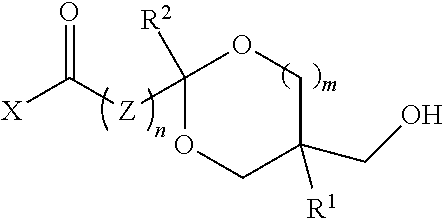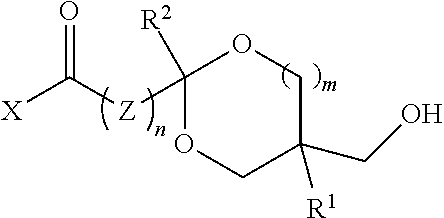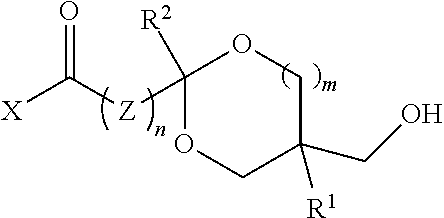High recycle content polyester polyols from hydroxy-functional ketal acids, esters or amides
a technology of hydroxy-functional ketal acids and polyester polyols, which is applied in the direction of polyurea/polyurethane coatings, adhesive types, coatings, etc., can solve the problems of difficult manufacturing of high-quality polyurethanes from recycled materials, releasing more greenhouse gases and pollutants, and increasing natural resources and energy consumption, etc., to achieve the effect of high recycling content, convenient production, and desirable hydroxyl numbers
- Summary
- Abstract
- Description
- Claims
- Application Information
AI Technical Summary
Benefits of technology
Problems solved by technology
Method used
Image
Examples
Embodiment Construction
[0019]In one aspect, the polyol comprises recurring units from a digested thermoplastic polyester, a glycol, and a hydroxy-functional ketal ester or amide.
[0020]Thermoplastic polyesters suitable for use are well known in the art. They are condensation polymers produced from the reaction of glycols and aromatic dicarboxylic acids or acid derivatives. Examples include polyethylene terephthalate (PET); polybutylene terephthalate (PBT); polytrimethylene terephthalate (PTT); glycol-modified polyethylene terephthalate (PETG); copolymers of terephthalic acid and 1,4-cyclohexanedimethanol (PCT); PCTA (an isophthalic acid-modified PCT); polyhydroxy alkanoates (e.g., polyhydroxybutyrate); copolymers of 2,2,4,4-tetramethyl-1,3-cyclobutanediol with isophthalic acid, terephthalic acid or orthophthalic derivatives; polyethylene furanoate; dihydroferulic acid polymers (e.g., poly(dihydroferulic acid) and poly(dihydroferulic acid-co-ferulic acid); see PCT Internat. Appl. No. WO 2014 / 075057, the tea...
PUM
| Property | Measurement | Unit |
|---|---|---|
| Temperature | aaaaa | aaaaa |
| Temperature | aaaaa | aaaaa |
| Temperature | aaaaa | aaaaa |
Abstract
Description
Claims
Application Information
 Login to View More
Login to View More - R&D
- Intellectual Property
- Life Sciences
- Materials
- Tech Scout
- Unparalleled Data Quality
- Higher Quality Content
- 60% Fewer Hallucinations
Browse by: Latest US Patents, China's latest patents, Technical Efficacy Thesaurus, Application Domain, Technology Topic, Popular Technical Reports.
© 2025 PatSnap. All rights reserved.Legal|Privacy policy|Modern Slavery Act Transparency Statement|Sitemap|About US| Contact US: help@patsnap.com



